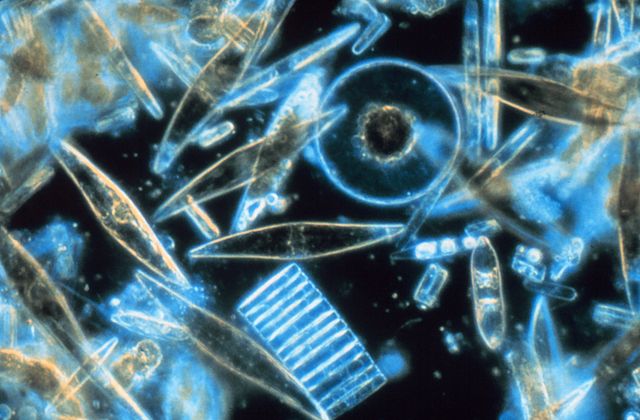Didymosphenia geminata, commonly known as didymo or rock snot, is a species of diatom that produces nuisance growths in freshwater rivers and streams with consistently cold water temperatures and low nutrient levels. It is native to the northern hemisphere, and considered an invasive species in Australia, Argentina, New Zealand, and Chile. Even within its native range, it has taken on invasive characteristics since the 1980s. It is not considered a significant human health risk, but it can affect stream habitats and sources of food for fish and make recreational activities unpleasant. This microscopic alga can be spread in a single drop of water.
Didymosphenia geminata
Seneca Creek in eastern West Virginia
Signs posted by Biosecurity NZ to warn of didymo threat in Waiau River.
Sign on New York's Esopus Creek advising anglers about didymo
A diatom is any member of a large group comprising several genera of algae, specifically microalgae, found in the oceans, waterways and soils of the world. Living diatoms make up a significant portion of the Earth's biomass: they generate about 20 to 50 percent of the oxygen produced on the planet each year, take in over 6.7 billion tonnes of silicon each year from the waters in which they live, and constitute nearly half of the organic material found in the oceans. The shells of dead diatoms can reach as much as a half-mile deep on the ocean floor, and the entire Amazon basin is fertilized annually by 27 million tons of diatom shell dust transported by transatlantic winds from the African Sahara, much of it from the Bodélé Depression, which was once made up of a system of fresh-water lakes.
Diatom
Intricate structures of the diatom Areolae (hexagonal or polygonal boxlike perforation with a sieve present on the surface of diatom) Striae (pores, punctae, spots or dots in a line on the surface) Raphe (slit in the valves) Central nodule (thickening of wall at the midpoint of raphe) Stigmata (holes through valve surface which looks rounded externally but with a slit like internal) Punctae (spots or small perforations on the surface) Polar nodules (thickening of wall at the distal ends of the raphe)
Selections from Ernst Haeckel's 1904 Kunstformen der Natur (Art Forms of Nature), showing pennate (left) and centric (right) frustules.
Light microscopy of a living diatom. Numbered graduations are 10 micrometres apart








